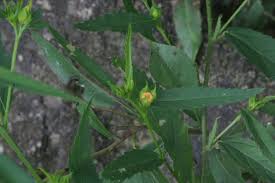Sida acuta, commonly known as the wireweed or broadleaf sida, is a perennial herb native to tropical and subtropical regions around the world. This plant has garnered significant attention in traditional medicine systems due to its diverse medicinal properties.
In various cultures, Sida acuta is utilized for its therapeutic potential, making it a valuable addition to the herbal pharmacopoeia. The leaves, stems, and roots of this plant are rich in bioactive compounds, including flavonoids, alkaloids, tannins, and saponins, which contribute to its health benefits and applications.
One of the most notable medicinal uses of Sida acuta is its role in managing inflammation. Traditionally, the plant has been employed to alleviate symptoms of inflammatory conditions, such as arthritis and muscle pain. The anti-inflammatory properties of Sida acuta can be attributed to its high content of flavonoids and phenolic compounds, which have been shown to inhibit inflammatory pathways in the body. By reducing inflammation, Sida acuta may help improve the quality of life for individuals suffering from chronic pain and related conditions.
Sida acuta is also recognized for its antibacterial properties. Research has demonstrated that extracts from the leaves and stems of this plant exhibit significant antimicrobial activity against various pathogens, including bacteria and fungi. This makes Sida acuta a promising candidate for developing natural antimicrobial agents.
Traditional healers have long used the plant to treat infections, wounds, and skin conditions. Its application in wound healing can be particularly beneficial in regions with limited access to conventional medical treatments.
In addition to its anti-inflammatory and antibacterial effects, Sida acuta is believed to possess analgesic properties. This makes it useful for managing pain associated with various ailments. Herbal preparations derived from Sida acuta are often used to relieve headaches, muscle cramps, and other discomforts.
The analgesic potential of this plant can provide a natural alternative to over-the-counter pain relief medications, particularly for individuals seeking holistic approaches to health.
Furthermore, Sida acuta is known for its potential in supporting digestive health. Traditional uses include treating gastrointestinal disorders such as diarrhea and dysentery. The plant’s ability to promote gut health can be attributed to its antidiarrheal properties, which may help regulate bowel movements and alleviate gastrointestinal discomfort.
Additionally, Sida acuta is thought to possess detoxifying effects, aiding in the elimination of toxins from the body and supporting overall digestive function.
The plant’s adaptogenic properties also contribute to its medicinal applications. Adaptogens are substances that help the body adapt to stress and maintain balance. Sida acuta may enhance the body’s resilience to stressors, making it valuable for individuals experiencing anxiety or emotional challenges. By promoting relaxation and reducing stress levels, Sida acuta can support mental well-being and improve overall quality of life.
As research continues to explore the health benefits and applications of Sida acuta, it becomes increasingly clear that this versatile herb holds great potential for both traditional and modern medicinal practices.
From managing inflammation and infections to promoting digestive health and mental well-being, Sida acuta offers a wide range of therapeutic possibilities. Understanding these medicinal uses can empower individuals to incorporate this herb into their health and wellness routines, tapping into its natural healing properties.
Historical Significance of Sida Acuta in Traditional Medicine

Sida acuta, also known as wireweed or broadleaf sida, has a rich historical significance in traditional medicine across various cultures, particularly in Africa, Asia, and parts of the Americas. This perennial herb has been used for centuries due to its diverse therapeutic properties, making it an integral part of many indigenous healing practices.
The use of Sida acuta in traditional medicine can be traced back to ancient times, where it was valued not only for its medicinal qualities but also for its resilience and adaptability in various environments. In many African communities, the plant has been employed as a remedy for a wide range of ailments. Traditional healers often used Sida acuta to treat inflammatory conditions, skin diseases, and infections, leveraging its anti-inflammatory and antimicrobial properties. It is common for local healers to create infusions, poultices, or decoctions from the leaves and stems to treat wounds, rashes, and other skin issues, highlighting the plant’s importance in local herbal pharmacopoeias.
In Asian traditional medicine systems, particularly in Ayurveda and Traditional Chinese Medicine (TCM), Sida acuta has also found its place as a beneficial herb. In Ayurveda, the plant is recognized for its ability to balance the body’s doshas, particularly Pitta and Kapha, and is used to support digestive health and detoxification. In TCM, Sida acuta is sometimes incorporated into formulas aimed at enhancing the body’s vital energy (Qi) and promoting overall health.
The historical significance of Sida acuta is further underscored by its inclusion in folk medicine practices among indigenous peoples. For example, in parts of South America, the plant is utilized for its analgesic properties to relieve pain and discomfort. Local healers have shared knowledge about its uses across generations, often combining Sida acuta with other herbs to enhance its therapeutic effects. This practice of combining multiple plants reflects a holistic approach to healing, emphasizing the interconnectedness of physical, mental, and spiritual well-being.
Moreover, the plant’s adaptability and rapid growth have contributed to its widespread use. Sida acuta thrives in various habitats, from disturbed soils to agricultural fields, making it readily available to communities that rely on local resources for their healthcare needs. This accessibility has solidified its status as a staple in traditional medicine, especially in areas where access to modern medical facilities may be limited.
The continued interest in Sida acuta’s medicinal properties in contemporary herbal medicine underscores its historical significance. Modern research has started to validate many traditional uses, exploring the pharmacological mechanisms behind its healing effects. Studies have demonstrated its anti-inflammatory, antimicrobial, and analgesic properties, aligning with the historical applications of the plant in various cultures. This convergence of traditional knowledge and scientific research enhances the appreciation for Sida acuta, affirming its value as a natural remedy.
Chemical Composition and Nutritional Value of Sida Acuta
Sida acuta, commonly known as the “wireweed” or “broadleaf weed,” contains a variety of bioactive compounds contributing to its nutritional and medicinal value. Key components include:
1. Phytochemicals: Sida acuta is rich in various phytochemicals, including flavonoids, phenolic acids, alkaloids, and terpenoids. These compounds are responsible for many of its medicinal properties, including antioxidant and anti-inflammatory effects.
2. Nutritional Profile:
i. Vitamins: Sida acuta contains essential vitamins such as vitamin A (beta-carotene), vitamin C, and various B vitamins (like B1, B2, and B6). These vitamins play crucial roles in maintaining immune function, skin health, and energy metabolism.
ii. Minerals: It is a source of important minerals, including calcium, potassium, magnesium, and iron. These minerals are vital for various physiological functions, including bone health, muscle function, and oxygen transport in the blood.
iii. Proteins: Sida acuta has a moderate protein content, which can be beneficial for vegetarians and those seeking to supplement their diet with plant-based proteins.
3. Dietary Fiber: The leaves and stems of Sida acuta are high in dietary fiber, promoting digestive health and helping to maintain healthy cholesterol levels.
Read Also: 13 Medicinal Health Benefits of Arum cylindraceum (tuberous wild calla)
Antioxidant Properties of Sida Acuta

Sida acuta is renowned for its strong antioxidant properties, which are primarily due to its rich content of phytochemicals. Important aspects include:
1. Free Radical Scavenging: Antioxidants in Sida acuta, such as flavonoids and phenolic compounds, help neutralize free radicals, reducing oxidative stress in the body. This action is crucial for preventing cellular damage linked to chronic diseases, including cancer and cardiovascular diseases.
2. Health Benefits: The antioxidant properties contribute to overall health by protecting cells from damage, enhancing immune function, and reducing inflammation. Consuming Sida acuta may help lower the risk of chronic conditions associated with oxidative stress.
3. Research Findings: Studies have demonstrated that extracts from Sida acuta exhibit significant antioxidant activity, suggesting its potential role in health supplements aimed at improving overall wellness and longevity.
Anti-inflammatory Effects of Sida Acuta
Sida acuta has been recognized for its anti-inflammatory properties, making it useful in managing various inflammatory conditions. Key points include:
1. Mechanism of Action: The bioactive compounds in Sida acuta inhibit the production of pro-inflammatory cytokines and enzymes, which play a key role in the inflammatory response. This action helps reduce swelling, redness, and pain associated with inflammation.
2. Application in Health: Its anti-inflammatory effects can be beneficial for conditions such as arthritis, allergies, and skin inflammations. Regular consumption or topical application of Sida acuta may help alleviate symptoms of these conditions.
3. Research Evidence: Scientific studies have confirmed the anti-inflammatory activity of Sida acuta, supporting its traditional use in managing inflammatory disorders. This reinforces its value in both alternative and complementary medicine.
Role of Sida Acuta in Treating Respiratory Conditions
Sida acuta has a significant role in respiratory health, particularly in managing conditions such as asthma, bronchitis, and respiratory infections. Important aspects include:
1. Expectorant Properties: Sida acuta acts as a natural expectorant, helping to clear mucus from the airways. This is particularly beneficial for individuals suffering from respiratory infections or chronic conditions that produce excess mucus.
2. Soothing Irritation: The anti-inflammatory and soothing properties of Sida acuta can help alleviate throat irritation and coughing, providing relief to those with respiratory distress.
3. Traditional Remedies: Traditionally, Sida acuta has been used in herbal teas and decoctions to treat respiratory ailments. Its application in folk medicine highlights its historical significance in respiratory care.
4. Scientific Support: Preliminary studies suggest that Sida acuta may possess bronchodilator effects, which can help improve airflow in individuals with asthma or chronic obstructive pulmonary disease (COPD). Further research is needed to fully understand its potential in respiratory therapy.
Sida Acuta for Digestive Health
Sida acuta has been traditionally recognized for its supportive role in promoting digestive health. Key aspects include:
1. Rich in Dietary Fiber: The leaves of Sida acuta are high in dietary fiber, which is essential for maintaining a healthy digestive system. Fiber aids in regulating bowel movements, preventing constipation, and promoting overall gut health by fostering a balanced gut microbiome.
2. Anti-inflammatory Properties: Sida acuta possesses anti-inflammatory compounds that can help soothe the digestive tract. This property may be particularly beneficial for individuals suffering from inflammatory bowel diseases, such as Crohn’s disease or ulcerative colitis.
3. Antioxidant Benefits: The antioxidant properties of Sida acuta help protect the digestive system from oxidative stress, which can lead to cellular damage and contribute to various gastrointestinal disorders.
4. Traditional Uses: In traditional medicine, Sida acuta has been used to relieve symptoms of digestive discomfort, such as bloating and gas. Herbal preparations often include Sida acuta to enhance digestion and promote appetite.
5. Modern Research: While more studies are needed, some research has suggested that Sida acuta may have protective effects on the gastrointestinal tract, supporting its traditional use as a remedy for digestive issues.
Read Also: 11 Medicinal Health Benefits of Albizia julibrissin (The Persian Silk Tree)
Sida Acuta and Its Antimicrobial Activity

Sida acuta has demonstrated significant antimicrobial activity, making it valuable in both traditional and modern medicine. Important points include:
1. Broad-Spectrum Antimicrobial Properties: Research indicates that extracts of Sida acuta possess antimicrobial effects against a variety of pathogens, including bacteria, fungi, and viruses. This broad-spectrum activity makes it a potential candidate for natural antimicrobial treatments.
2. Mechanism of Action: The antimicrobial activity of Sida acuta is attributed to its rich phytochemical composition, including flavonoids and other secondary metabolites that inhibit the growth of harmful microorganisms.
3. Traditional Medicine Applications: Traditionally, Sida acuta has been used to treat infections and skin ailments. Its antimicrobial properties support its use in herbal preparations aimed at combating infections, both internally and externally.
4. Potential in Wound Healing: The antimicrobial effects of Sida acuta can be beneficial in wound care, as it may help prevent infections in minor cuts and abrasions when applied topically.
5. Emerging Research: Ongoing studies are investigating the potential of Sida acuta as a natural antimicrobial agent, which could lead to new treatments for antibiotic-resistant infections.
Applications of Sida Acuta in Skin Care
Sida acuta has a variety of applications in skin care, attributed to its beneficial properties. Key considerations include:
1. Anti-inflammatory Benefits: The anti-inflammatory properties of Sida acuta can help soothe irritated skin and reduce redness, making it useful for conditions such as eczema and psoriasis.
2. Antimicrobial Action: Due to its antimicrobial properties, Sida acuta can help prevent and treat acne by inhibiting the growth of acne-causing bacteria. Incorporating Sida acuta extracts in topical formulations can enhance skin health and cleanliness.
3. Antioxidant Protection: The antioxidants found in Sida acuta help protect the skin from oxidative stress caused by environmental factors such as UV exposure and pollution. This protective effect can slow down the aging process and improve skin tone and texture.
4. Traditional Skin Remedies: In various cultures, Sida acuta has been used in poultices and infusions for topical application to promote healing of cuts, rashes, and other skin issues. Its traditional use underscores its value in herbal medicine.
5. Cosmetic Formulations: Modern cosmetic companies are exploring the inclusion of Sida acuta in skin care products, such as creams, lotions, and serums, due to its beneficial effects on skin health.
Sida Acuta in Managing Diabetes
Sida acuta has gained attention for its potential benefits in managing diabetes, primarily due to its phytochemical properties. Key points include:
1. Hypoglycemic Effects: Research indicates that Sida acuta may help lower blood sugar levels. The plant contains compounds that may enhance insulin sensitivity and stimulate glucose uptake in cells, thus supporting better blood sugar control.
2. Antioxidant Properties: The oxidative stress that occurs in diabetes can lead to complications. The antioxidant properties of Sida acuta help combat oxidative damage, potentially reducing the risk of diabetes-related complications such as neuropathy and retinopathy.
3. Traditional Use: In various traditional medicine practices, Sida acuta has been used to treat diabetes and related symptoms. Herbal practitioners often incorporate Sida acuta into formulations aimed at managing blood sugar levels.
4. Anti-inflammatory Benefits: Chronic inflammation is a concern in diabetes management. Sida acuta’s anti-inflammatory properties can contribute to reducing systemic inflammation, which is beneficial for individuals with diabetes.
5. Potential in Complementary Therapy: While Sida acuta shows promise as a complementary approach to diabetes management, it should not replace conventional treatments. Individuals with diabetes should consult healthcare professionals before incorporating Sida acuta into their management plan.
Safety and Side Effects of Sida Acuta
While Sida acuta is generally considered safe for consumption, some safety considerations and potential side effects include:
1. Mild Side Effects: Some individuals may experience mild side effects such as gastrointestinal discomfort, nausea, or diarrhea when consuming Sida acuta, especially in large quantities. It’s advisable to start with a small dosage to assess tolerance.
2. Allergic Reactions: Rarely, individuals may have allergic reactions to Sida acuta. Symptoms may include itching, rashes, or swelling. Anyone experiencing these symptoms should discontinue use and consult a healthcare professional.
3. Interaction with Medications: Sida acuta may interact with certain medications, particularly those for diabetes. Combining Sida acuta with blood sugar-lowering medications could lead to hypoglycemia (low blood sugar). It’s essential for individuals on diabetes medication to discuss the use of Sida acuta with their healthcare provider.
4. Pregnancy and Lactation: There is limited research on the safety of Sida acuta during pregnancy and lactation. Therefore, it is recommended that pregnant or nursing individuals avoid using Sida acuta unless advised by a healthcare professional.
Future Research Directions on Sida Acuta
Research on Sida acuta is still evolving, and several future directions could provide deeper insights into its benefits and applications:
1. Clinical Trials: More rigorous clinical trials are needed to establish the efficacy and safety of Sida acuta for diabetes management. Studies should focus on its effects on blood glucose levels, insulin sensitivity, and overall metabolic health.
2. Mechanistic Studies: Understanding the specific biochemical mechanisms through which Sida acuta exerts its effects on blood sugar control and inflammation could enhance its potential therapeutic applications.
3. Phytochemical Analysis: Investigating the various phytochemicals present in Sida acuta can help identify the active compounds responsible for its health benefits. This could lead to the development of standardized extracts for therapeutic use.
4. Formulation Development: Research into creating effective formulations, such as supplements or functional foods incorporating Sida acuta, could make it more accessible for diabetes management.
5. Comparative Studies: Studies comparing Sida acuta with other herbal remedies for diabetes management can help position its role in holistic approaches to managing the condition.
6. Broader Applications: Exploring the potential applications of Sida acuta in other health conditions, such as cardiovascular health or metabolic syndrome, could broaden its use in natural health products.
Do you have any questions, suggestions, or contributions? If so, please feel free to use the comment box below to share your thoughts. We also encourage you to kindly share this information with others who might benefit from it. Since we can’t reach everyone at once, we truly appreciate your help in spreading the word. Thank you so much for your support and for sharing!
Read Also: What is some advantages of solar energy?
Frequently Asked Questions
We will update this section soon.
